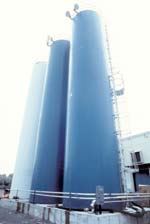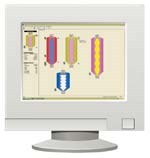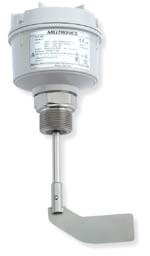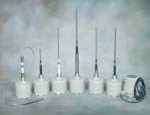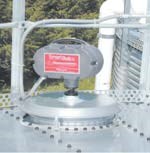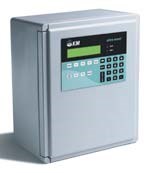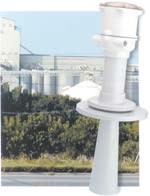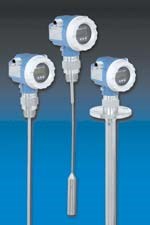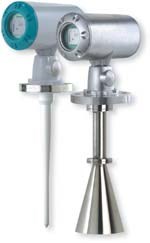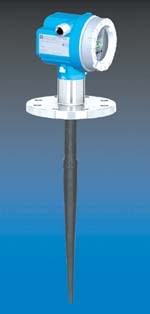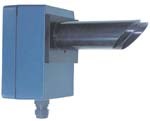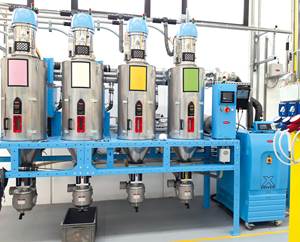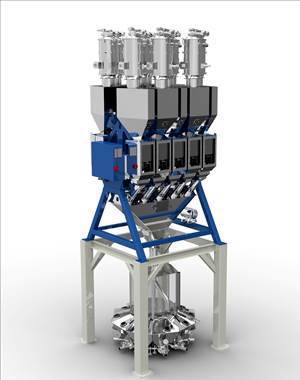Improved Technology Tightens Your Grip on Materials Inventory Control
Know what's new in paddle switches or weight-and-cable sensors? What about capacitance, vibratory, and ultrasonic level gauges? Are radar or laser systems worth the money? It's time to get educated: Having the right tools for materials management is more important than ever.
How much material is left in your silo, bin, or bulk tank? Is there enough to finish the job run? How soon must you reorder? Plastics processors in today's environment of tight cost controls and Just-in-Time deliveries cannot afford to leave such questions unanswered. Nor can they af ford wrong ans wers from inaccurate inven tory controls.
Fortunately, processors who store substantial quantities of bulk solid or liquid raw materials have a full kit of new tools to help them keep track of those pounds and gallons. Today's level-detection instruments offer more choices than ever. There is an expanding range of level-sensing technologies, and lots of new-product developments at all levels of sophistication. These range from updated versions of simple, tried-and-true paddle switches and weight-and-cable monitors to new generations of more high-tech capacitance, radar, and laser systems.
Proliferation of networkable systems makes possible remote monitoring of material levels and other information, such as rate of usage, which can be extrapolated to predict when material will need replenishing before it is needed. Such information can be made available to purchasing, corporate management, and even raw-materials suppliers. Some of them offer new vendor-managed inventory programs, which take the burden off the processor to make sure the machine hoppers never run dry. "More and more companies want suppliers to monitor their silos," observes Joe Lewis, v.p. of sales and marketing at Monitor Technologies.
Says Stan Isen hath, marketing manager at Kist ler-Morse, "Le vel sensing has be come a materials-management and logistics issue." He says level sensors there by contribute to better utilization of storage capacity and capital tied up in materials. Isenhath cites industry estimates that some $160 billion/yr is spent on logistics, and the right tools—including level sensors—could shave 10% to 15% off that cost.
Two basic categories
Level sensors divide into two classes: point level probes and continuous level monitors. Point level sensors are contact instruments. They are the simplest devices for telling whether material is at or above a certain point in a vessel. Depending where you put them, they can signal when a vessel is full, empty, or at some level in between. This type of sensor includes rotary paddle switches and vibratory probes for dry bulk solids, as well as capacitance probes for both solids and liquids. Most suppliers offer at least one, if not all, of these types of devices. More than 70% of plastics processors and compounders utilize this type of device.
Whereas point-level probes provide no information about material level between the discrete measurement points, continuous level monitoring avoids those blank spots. This category includes contact instruments ranging from weight-and-cable based "smart" sensors to the guided-wave radar. These are used primarily for dry bulk solids. There are also non-contact continuous sensors of ultrasonic, open-air radar, and laser types, which can be used with both solids and liquids, depending on the instrument. All of these measure the distance from the sensor at the top of the vessel to a point on the surface of the material.
Also worth mentioning is an altogether different method of continuous level monitoring—by weighing the vessel and its contents. Bins, tanks, and even silos can be mounted on load cells, though this approach is generally practical only for new installations, not retrofits.
The most commonly used continuous level-monitoring technologies are weight-and-cable and ultrasonics. Traditional weight-and-cable types are estimated to account for some 60% of these installations.
Suppliers often note that point level versus continuous level measurement is not necessarily an either/or decision. Point level sensors can be used alone, but they should also be utilized as a backup for continuous level sensors—at least at the high-level point to prevent overfill. Says Keith Gottelman, product engineer at Conair, "We suggest the use of point level sensors in addition to continuous level types. We most often recommend two rotary paddles—one at the top of the silo and one at the bottom."
Rotary-Paddle Switches
Rotary paddles are one of the oldest types of level sensors and still the most common in plastics. They are the lowest-cost option, ranging from about $160 to $255 apiece. Rotary paddles are easy to use, reasonably reliable, and applicable to all kinds of dry bulk materials—flakes, pellets, or powders. As mechanical devices, their one weakness has been susceptibility to wear and tear.
These units have a small electric motor to turn a shaft with one to three vanes or paddles. If the shaft turns freely, no material is present. If the paddles encounter material, the shaft stalls and signals material presence at that level in the vessel. Higher-end units not only indicate material presence, but have various "fail-safe" mechanisms to detect when the device is not working properly due to power failure or other problems.
Rotary-paddle switches remain so popular that even suppliers of higher-end instruments are adding them to their lines. Siemens Energy and Automation (known in Canada as Siemens Milltronics) brought out the Milltronics Pointek PLS 200, whose rugged design and new friction clutch are said to increase longevity and reliability, even in harsh conditions.
K-Tek introduced the KP1 Roto Paddle Switch, which has a rugged enclosure and four different paddle options.
Capacitance Probes
Capacitance level probes are available for use with dry bulk and liquid materials and there are types for both point level and continuous measurement. In plastics, point level capacitance probes are more widely used.
These all-solid-state electronic devices consist of a probe that is mounted outside of the storage vessel and penetrates the wall to contact the material inside. The probe senses the presence of material by the change in electrical capacitance when air or material is present. While sometimes referred to as RF (radio-frequency) capacitance probes, some models can operate at frequencies below the radio band. Prices range from $230 to $800.
Their drawback is that they require calibration—and then recalibration if the vessel is charged with a new material having a different dielectric constant. Says Todd Peterson, sales and marketing director at Binmaster, "Processors who work with a consistent material will often opt for these. They have no moving parts and no motor to burn out."
Joe Lewis at Monitor Technologies adds that some materials—particularly powders—tend to coat the probe of standard capacitance units. "Most units today have electronics that nullify that problem," he says, citing Monitor's new TrueCap Model MK-2e. It boasts better calibration stability and superior sensitivity.
K-Tek just came out with the A38 low-cost capacitance sensor for solids and liquids.
Vibratory Probes
Vibratory probes are typically mounted on the top or side of storage vessels for dry bulk materials. Most of today's vibratory probes use a piezoelectric quartz crystal to excite high-frequency vibrations in the probe. Contact with the material dampens the probe's vibration and triggers a relay. Single-rod units are used in solids, while tuning-fork probes can be used in liquids or solids.
This all-electronic point-level technology has two advantages. One is that it does not require calibration for the particular material. The other is that these probes can sense very lightweight materials such as EPS or fluffy regrind—typically down to densities of 2 to 3 lb/cu ft, although some instruments can sense material as light as 1.3 to 1.5 lb/cu ft.
Drawbacks include higher cost—typically $400 to $800—and the tuning-fork type tends to be sensitive to material build-up between the tines. In that vein, Binmaster's Peterson warns that sticky materials are the worst for these units.
Siemens has introduced a new tuning-fork level switch, the Pointek VLS 200, primarily for fluffy and other low-bulk-density materials down to 1.3 lb/cu ft. Fork oscillation constantly cleans the tines, the company says, and the patented design is said to eliminate false high-level readings.
Roy Zielinski, applications engineer at Venture Measurement, says the Bindicator Pulse Point Model LP 30 tuning fork for dry solids, launched a couple of years ago, has been very popular in plastics, including EPS. "We have seen it replacing capacitance and rotary-paddle units," he claims.
Weight & Cable Systems
Weight-and-cable devices, also known as plumb bobs, have been around for decades. They started out as simple electromechanical devices, but most have been replaced by a sensor that uses optical techniques and a microcontroller, resulting in very high resolution, accuracy, and torque control. They are primarily used for dry solids but can be outfitted to work with liquids.
Suppliers include Venture Measurement, with its Bindicator GP Yo-Yo; BinMaster with its Bob and Smart-Bob II units; and Monitor Technologies with its SiloPatrol inventory-monitoring system. (Thermo Ramsey, a maker of ultrasonic and other sensors, also markets the Bob and Smart Bob II.)
These devices typically involve lowering a weighted cable into a vessel. The weight stops when it reaches the surface of the material and then retracts into a sensor housing mounted on top of the vessel. Electronics in the sensor housing control the motor direction and measure the distance the weighted cable travels in both the descent and ascent.
These devices are not affected by dust, fumes, humidity, temperature, material density, or its dielectric properties. Weight-and-cable systems require no calibration and work on virtually any material with minimal contact. The only apparent drawback of the newer-technology units is that they are not truly continuous: They make periodic on-demand measurements, though this reportedly is adequate for most plastics applications.
Monitor Technologies' Joe Lewis places the starting price for a cable-based "smart"-sensor unit at about $1100, including electronics and RS-45 two-wire cable. For an additional $500 to $1000, you can get an alphanumeric control console. PC server software for controlling up to 128 sensors starts at $900, while software for remote computer access via wireless LAN, internet, or dial-up connections sells for around $500. Lewis says remote access and wireless communication capability (which cuts installation time and cost) have "re-energized" weight-and-cable technology. "Whereas ultrasonics had been replacing the old weight-and-cable systems over the last 15 years, weight-and-cable is now replacing ultrasonic technology."
Monitor's SiloPatrol inventory-management system, launched in 1999, can monitor the level of materials in bins, silos, and tanks up to 150 ft high. The SiloPatrol model SMU provides substantially improved motor and cable strength and generates resolution of 100 pulses per foot. It can be offered as a stand-alone sensor with analog output and no operator display, but the standard "smart" version of the SMU has an operator interface with communication capabilities. Up to 128 smart sensors can communicate wirelessly with Monitor's SiloTrack PC-based, graphical inventory-management software.
Binmaster launched the Smart Bob II Remote system two years ago. It can measure levels of vessels up to 150 ft high. A direct-drive motor provides increased power, and a tough plastic housing seals off the electrical from the mechanical components. Its microcontroller counts the sensor probe's pulses from an optical encoder that produces 80 pulses per foot, providing higher resolution than competitive models with 12 to 40 pulses/ft.
Binmaster also offers several hardware and software combinations for networking and communications. SmartBob Console is a simple pushbutton console for up to 30 Smart Bob II Remote sensors. The PC/ ActiveX Controlled Smart Bob II works with a PC using Binmaster's networkable inventory-management software to control up to 128 sensors.
Venture Measurement expects to introduce a networkable version of its Bindicator Yo-Yo within the next six months.
Ultrasonic Sensors
Like weight-and-cable systems, ultrasonic sensors are mounted on top of the silo. A sonic impulse is generated by a transducer. The material level is determined by exactly measuring the "time of flight" of the impulse as it travels to the material, reflects off its surface, and bounces back to the sensor.
Ultrasonic continuous level sensors are non-contact, react instantaneously to changes in material level, and are often cost-competitive for large, multi-vessel systems. Low-end ultrasonic units, which typically include the sensor and controller, average $1200 to $1300, while higher-end units with multi-function software go up to $2000. Suppliers include Endress + Hauser, K-Tek, Kistler-Morse, Monitor Technologies, Siemens, Thermo Ramsey, and Venture Measurement.
Ultrasonic sensors were initially developed primarily to measure liquid levels. Liquids afford a flat surface and little turbulence in the vessel headspace. These sensors revealed shortcomings when applied to dry bulk solids. Some plastics absorb the ultrasonic signal rather than reflecting it. Uneven material surfaces can obscure signal reflection. Internal vessel structures can block signals. Dry solids have an "angle of repose" that can produce erroneous level readings if the sensor is aimed improperly. Air turbulence, dust, and temperature variations of 20°F or more can also cause erroneous readings. Ultrasonic sensors also must be calibrated for each material type and vessel configuration.
Says Conair's Gottelmann, "While ultrasonics sounded good in theory, in practice they have proven to be troublesome with plastic pellets—both unreliable and unable to hold calibration—although they work very well with liquids." He does concede that some newer units compensate for these weaknesses by using lower-frequency sound waves.
Thermo Ramsey's new SonaTech and SonaMaster ultrasonic level sensors are designed to address the problems of measuring bulk solids as well as liquids. They use lower frequencies that are better at carrying for long distances and penetrating dust clouds. They also eliminate the need for "aiming kits" because the return signals are stronger. If they lose track of the sonic echo, these devices pump up the amplitude (get louder).
Kistler-Morse has a new ultrasonic level system that can monitor both solids and liquids with up to 16 transducers of various frequencies (10 to 45 kHz). It features K-M's Sentry DSP filter, which reportedly provides stable, accurate readings under a variety of conditions. It digitally separates the true level signal from the "noise" caused by dynamic conditions in most vessels.
Designed specifically for plastics, K-M's Ultra-Wave is compatible with a variety of transducers. These include the firm's new Ultra-Cell sensor, which is said to be well suited to plastics pellets. It has a narrow beam angle of only 5°, half that of conventional units, allowing it to "see" all the way down the tapered conical portion at the bottom of a tank. It also uses a 24-kHz beam signal, a frequency that K-M has found to be reflected most efficiently by all types of plastic pellets.
Kistler-Morse also offers the new ORB 2.0 communications system that interfaces with Inter net/Intranet networks.
K-Tek recently introduced the K-Soniks line of sensors that can measure as far as 200 ft.
Guided-Wave Radar
This technology, sometimes referred to as "radar on-a-rope," is a contact-type continuous measurement method geared to dry bulk solids. The device is mounted on top of the vessel. A microwave signal is sent down a stainless-steel cable or rod into the silo. When the signal reaches the surface of the material, it is reflected back up along the cable. The distance to the material is calculated based on time of signal travel.
These systems' cost of around $1500 to $1600 is very competitive with that of long-range ultrasonics at $1800 to $2000. Suppliers include Endress + Hauser, K-Tek, Ohmart/ Vega, Siemens, and Venture Measurement.
As with ultrasonics, a key advantage is instantaneous reaction to changes in material level. These all-electronic units can measure over short or long distances and are impervious to dust, air movement, temperature, or pressure fluctuations.
On the other hand, heavy material build-up on the sensor can cause false readings. And since they measure level at one point, their readings can be affected by the material's angle of repose. Guided-wave radar also has difficulty sensing plastic materials with extremely low dielectric constants, such as EPS beads. However, it is said to work very well with plastic pellets and flakes.
Ohmart/Vega has received good response from plastics processors to its Vegaflex guided-wave radar device, says marketing manager Brian Oeder. Since it was introduced two years ago, it has replaced both ultrasonic units and me chanical sensors, he says. The detachable cable allows users to stock spares. Its so phisticated software and cable pull-force rating of up to 4 tons reportedly help track levels over long distances in a silo.
Endress + Hauser recently brought out the Levelflex M FMP, a new guided-wave unit featuring sophisticated signal-evaluation software and an extended measuring range of up to 115 ft. It's said to work with powders and pellets having a minimum dielectic constant of 1.6.
Also new in last two years is the MT2000 guided-wave radar sensor from K-Tek. It is said to measure the level of solids and liquids with an unmatched accuracy of ±0.20 in. According to marketing director Kevin Hambrice, this transmitter overcomes the false echoes and complicated set-up normally associated with non-contact types of radar level transmitters. It reportedly provides accurate level measurement at up to 122 ft, even under harsh conditions and wide variations in temperatures and pressures.
Open-Air Radar
Open-air or free-space radar uses non-contact sensors that beam microwaves at the material's surface from the top of the vessel. The pulses of electromagnetic energy are reflected off the material and the level is determined by the signal's time of flight. Starting price is around $3000. Suppliers include Endress + Hauser, Ohmart/Vega, and Siemens.
These units provide an instantaneous reaction to changes in material level. However, their accuracy can be limited by vessel obstructions, agitation, elevated pressures, the angle of solid surfaces, and materials with dielectric constants less than 1.6. They are best suited to liquids and a typical maximum vessel height of 115 ft. Ohmart/Vega's VegaPulse radar series has been used for measuring liquid levels in plastics applications since the early 1990s. Brian Oeder says the system is not perturbed by temperature and pressure fluctuations.
Endress + Hau ser's 18-month-old Micropilot M system for liquid components boasts low maintenance and fewer problems with build-up than other units.
Siemens recently introduced the Sitrans LR 300 and LR 400 open-air radar series, which reportedly offer enhanced communications. LR 300 is for liquids only while LR 400 can also be used with pellets, according to marketing manager Jerry Voisvert. Both utilize low frequencies and are reportedly unaffected by temperature or pressure extremes. Their Sonic Intelligence signal-processing software is said to differentiate between true echoes from the material and false echoes generated by obstructions or electrical noise.
Last May, Siemens also introduced a remote inventory-monitoring service. "By logging into a secure customized website, Levelwatch.com, you can monitor remote storage bins and tanks holding virtually any bulk material, including plastic pellets or specialty chemicals," says Voisvert. A Levelwatch.com unit collects data from level detectors—radar or ultrasonic—via wireless modem on this web site. The system monitors levels, tracks trends, and send alarms directly to designated personnel by phone, fax, pager or e-mail. There is no network or software to set up or configure.
Laser Sensors
Laser sensors are in their infancy for measuring levels of bulk solids and opaque liquids. Currently, the only maker of laser level meters in the U.S. is K-Tek. The company says it can deliver these sensors at one-third to one-half the cost of imported units. It has two brand-new models that are priced lower than ever.
K-Tek's Hambrice says that about 80% of these units are used for dry solids, including plastics such as PE, PP, PVC, and EPS. The company's LM4C sensor and its more lightweight cousin, the LM02, are said to be easily mounted, energy efficient, and easily programmed with a PC or handheld computer. They employ Class I lasers, which are safe for the human eye.
Because the K-Tek laser wavelength is only 1 micron, as opposed to radar's wavelength of 10,000+ microns, it reportedly has virtually no beam divergence, which means no false echoes, and easily measures surfaces at an angle. The narrow laser beam can pass through screens. It can traverse distances of up to 120 meters.
Both Ohmart/Vega and Endress + Hauser opted to drop laser technology a few years back in favor of radar sensors. Both firms said a major problem was the tendency for dust to obscure the optical lens, though this was more of a problem with powders than pellets.
Load Cells
An entirely different method of continuously monitoring the contents of storage vessels is to weigh them. Mounting vessels on load cells avoids the two common flaws shared by most continuous level-measuring techniques. First, weight measurements are unaffected by the angle of repose of solid materials. Second, level sensors cannot detect "rat holes" that occur below the material surface. On the other hand, load-cell weighing systems can be very sensitive to temperature and wind turbulence. They also cost several thousand dollars per silo.
Load-cell systems are not usually a retrofit option for existing silos. An exception is the C-Level system from Thermo Ramsey. Its installation kit instructs users on press-fitting the sensors into the metal support structure—usually the skirt—of the silo. A set of four strain gauges costs around $3000 and six gauges runs $4000.
Conair's Gottelmann says his company suggests load cells for new silo installations. A silo on four load cells can monitor the resin inventory within a 5-lb margin.
Related Content
Finding Efficiencies in How Components Work Together
Auxiliary systems are vital to the proper functioning of a plastic processing line, and they can be a source of major cost and efficiency improvements.
Read MoreACS Group Adds Regional Sales Manager
Richard Gutierrez named Southwest regional sales manager.
Read MoreHow to Effectively Reduce Costs with Smart Auxiliaries Technology
As drying, blending and conveying technologies grow more sophisticated, they offer processors great opportunities to reduce cost through better energy efficiency, smaller equipment footprints, reduced scrap and quicker changeovers. Increased throughput and better utilization of primary processing equipment and manpower are the results.
Read MoreAutomated Resin Management and Blending System for Tight Spaces
NPE2024: Designed for new and existing operations with up to 10 machines and limited available space.
Read MoreRead Next
Beyond Prototypes: 8 Ways the Plastics Industry Is Using 3D Printing
Plastics processors are finding applications for 3D printing around the plant and across the supply chain. Here are 8 examples to look for at NPE2024.
Read MorePeople 4.0 – How to Get Buy-In from Your Staff for Industry 4.0 Systems
Implementing a production monitoring system as the foundation of a ‘smart factory’ is about integrating people with new technology as much as it is about integrating machines and computers. Here are tips from a company that has gone through the process.
Read More


